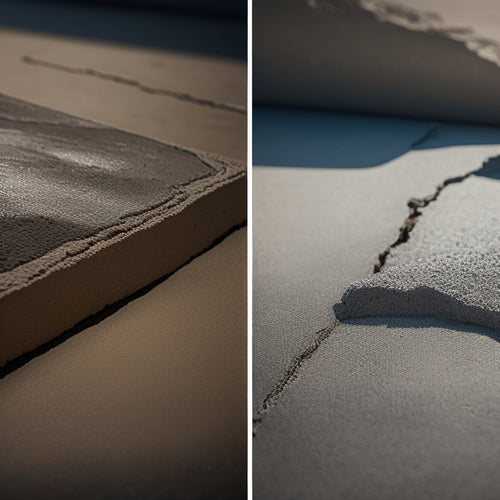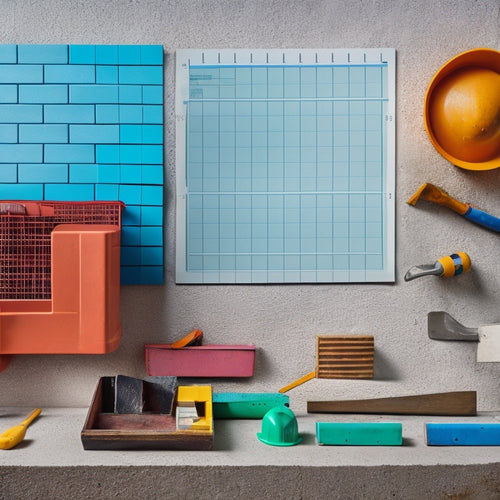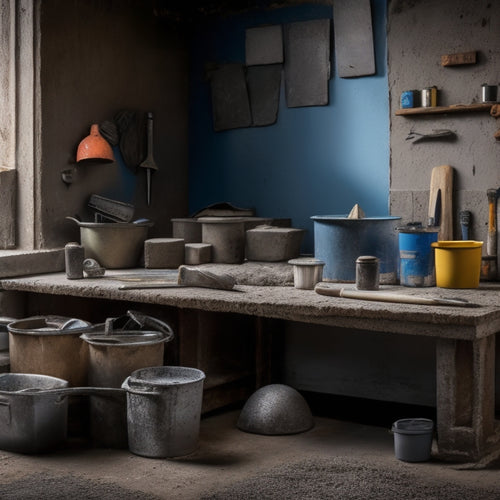
Protect and Prolong Your Concrete Finishing Tools
Share
You can greatly extend the life of your concrete finishing tools by adopting a few critical habits. Start by cleaning your tools regularly with mild detergent and pH-balanced cleaning solutions to prevent rust and corrosion. Properly store them in a dry, protected area, and maintain a regular lubrication routine to keep moving parts in top condition. Inspect your tools daily for signs of wear and damage, and sharpen or refurbish blades as needed. By following these best practices, you'll not only protect your investment but also guarantee smoother finishes and better project results - and that's just the beginning of how you can optimize your tool performance.
Key Takeaways
• Clean and sanitize tools regularly to prevent rust, corrosion, and surface damage, ensuring smoother finishes and better project results.
• Store tools in a dry, protected area away from sunlight and extreme temperatures to extend their lifespan and performance.
• Conduct daily inspections to catch damage before costly repairs, and schedule thorough maintenance every six months to maintain tool condition.
• Sharpen blades regularly to maintain cutting performance and tool lifespan, and master various sharpening techniques for optimal results.
• Apply rust-inhibiting coatings and store tools in a dry place to prevent moisture exposure and corrosion.
Cleaning Concrete Finishing Tools
After each use, scrub your concrete finishing tools with a stiff-bristled brush and mild detergent to remove dried concrete and prevent damage from residual alkalinity. This important step is often overlooked, but it's crucial to extend the lifespan of your tools.
Effective cleaning solutions, such as a mixture of water and trisodium phosphate, can help break down stubborn concrete residue. When choosing a cleaning solution, opt for a pH-balanced formula to prevent corrosion or damage to your tools.
Proper tool cleaning techniques are critical to maintaining the quality and performance of your concrete finishing tools. Regular cleaning prevents the buildup of concrete, which can lead to rust, corrosion, or damage to the tool's surface.
Additionally, clean tools guarantee a smoother finish and better results on your concrete projects. By incorporating these cleaning techniques into your routine, you'll be able to tackle even the most demanding projects with confidence and precision.
Storing Edgers and Trowels Properly
To prevent damage and extend the lifespan of your edgers and trowels, store them in a dry, protected area away from direct sunlight and extreme temperatures. This will help prevent rust, corrosion, and warping, ensuring your tools remain in top condition for your next concrete finishing project.
When storing your edgers and trowels, keep the following tips in mind:
-
Hang edgers: Suspend them from a hook or nail to prevent flat spots and maintain their original shape.
-
Organize trowels: Arrange them in a designated trowel arrangement, such as a trowel holder or rack, to prevent scratching and tangling.
-
Keep them clean: Store your edgers and trowels in a clean, dry state to prevent dirt and debris from accumulating and causing damage.
Sharpening and Refurbishing Blades
You'll also need to regularly sharpen and refurbish your blades to maintain their cutting performance and extend their lifespan. A dull blade not only reduces your productivity but also increases the risk of accidents and damages to your tools.
To sharpen your blades effectively, you'll need to master various sharpening techniques, including the use of diamond stones, water stones, and carbide saw blades. Proper blade alignment is essential to guarantee that your blades are sharpened evenly and accurately.
When refurbishing your blades, inspect them for signs of wear and tear, such as cracks, rust, or corrosion. Remove any debris or residue using a wire brush or a degreaser.
Next, re-sharpen the blades using the appropriate sharpening technique for your specific blade type. Finally, reassemble your tools and test them to confirm they're functioning at peak performance.
Lubricating Moving Parts Regularly
When it comes to lubricating moving parts regularly, you'll want to establish a routine that guarantees your concrete finishing tools remain in top condition.
You'll need to perform daily visual checks to identify potential issues before they become major problems.
Additionally, apply grease correctly to moving parts, and maintain a regular cleaning schedule to prevent dirt buildup.
Daily Visual Checks
Regular lubrication of moving parts is essential to extend the lifespan of your concrete finishing tools, and daily visual checks help confirm this important maintenance task isn't overlooked.
As a professional, you understand the importance of daily inspection techniques to identify wear signs that can lead to tool failure. By incorporating daily visual checks into your routine, you'll catch potential issues before they become major problems.
Here are three key areas to focus on during your daily visual checks:
-
Look for signs of wear: Inspect moving parts for signs of wear, such as excessive play, rust, or scoring.
-
Check lubricant levels: Verify that lubricant levels are within the recommended range to confirm proper protection.
-
Inspect seals and gaskets: Check seals and gaskets for signs of damage or leakage, which can compromise tool performance.
Proper Grease Application
Every moving part on your concrete finishing tool requires a sufficient amount of grease to function smoothly and prevent premature wear. You can't afford to neglect this significant step, as it directly impacts the tool's performance and lifespan.
When selecting a grease, you'll encounter various types, each designed for specific applications. For instance, lithium-based greases are ideal for high-temperature environments, while silicone-based greases are better suited for low-temperature conditions.
When applying grease, it's vital to follow proper techniques to guarantee even distribution and avoid over-greasing. Start by cleaning the area around the moving parts to remove any debris or dirt. Next, apply a small amount of grease to the designated area, using a grease gun or manual applicator.
Be cautious not to over-grease, as this can attract dirt and dust, causing more harm than good. Finally, operate the tool for a few minutes to allow the grease to distribute evenly.
Regular Cleaning Schedule
You must establish a routine cleaning schedule to maintain the performance and longevity of your concrete finishing tool's moving parts. Failing to do so can lead to premature wear, reduced efficiency, and even breakdowns. To avoid these issues, incorporate regular cleaning into your maintenance checklist.
Here are three key tasks to perform at each cleaning frequency:
-
Remove dirt and debris: Use a soft-bristled brush or cloth to wipe away dirt, dust, and other particles that can accumulate on moving parts.
-
Inspect and clean lubrication points: Check lubrication points for signs of wear or damage, and clean them thoroughly to guarantee proper lubricant flow.
-
Check for corrosion: Inspect moving parts for signs of corrosion, and apply a rust inhibitor or corrosion-resistant coating as needed.
Inspecting for Damage Daily
You make it a habit to inspect your concrete finishing tools daily, scouring every inch for signs of damage or wear.
This daily ritual is essential, as it allows you to catch issues before they escalate into costly problems.
Daily Visual Inspections
Regularly scrutinize your concrete finishing tools at the end of each workday to catch any damage before it escalates into costly repairs or compromised performance. Identifying wear and evaluating functionality are vital steps in maintaining the longevity of your tools. By doing so, you'll guarantee your tools continue to perform at their best, and you'll avoid unnecessary downtime.
Here are three essential areas to focus on during your daily visual inspections:
-
Tool edges and surfaces: Check for signs of wear, such as chipping, cracking, or excessive wear patterns. Identify any areas that require sharpening or repair.
-
Moving parts and mechanisms: Evaluate the functionality of gears, bearings, and other moving components. Look for signs of corrosion, rust, or excessive wear that could lead to premature failure.
-
Handles and grips: Inspect the condition of handles and grips, confirming they're secure, comfortable, and free from damage or wear.
Tool Condition Assessment
Daily tool condition evaluations pinpoint damage before it escalates, allowing for swift remediation and preventing catastrophic tool failures.
By inspecting your tools daily, you'll extend their lifespan and reduce maintenance frequency. This proactive approach helps you identify minor issues before they become major problems, saving you time and money in the long run.
When evaluating your tools, look for signs of wear, corrosion, or damage. Check for loose or damaged handles, rusty or bent blades, and worn-out pads or wheels.
Inspect electrical components for frays, cracks, or exposed wires. Make a mental note of any issues you find and prioritize repairs or replacements accordingly.
Wear and Tear Check
Conduct a wear and tear check by scrutinizing each tool's condition, focusing on high-wear areas where damage tends to manifest first.
You'll want to identify early signs of wear, such as scratches, cracks, or corrosion, to prevent them from becoming major issues. This daily inspection will help you stay on top of maintenance frequency, ensuring your tools remain in top condition.
As you inspect your tools, look for these key signs of wear:
-
Abnormal wear patterns: Check for uneven wear on blades, edges, or surfaces, which can indicate improper use or misalignment.
-
Visible damage: Inspect for cracks, dents, or corrosion that can compromise the tool's integrity.
-
Performance degradation: Monitor tool performance, and note any decline in efficiency or effectiveness.
Preventing Rust and Corrosion
To prevent rust and corrosion from damaging your concrete finishing tools, you should store them in a dry place or use a rust-inhibiting coating after each use. This is especially important for tools made from steel, as they're more prone to corrosion. By taking these precautions, you'll be able to extend the lifespan of your tools and guarantee they remain in top condition.
Here are some rust prevention techniques and corrosion resistance materials you can use:
| Material | Technique | Effectiveness |
|---|---|---|
| WD-40 | Spray coating | High |
| Silicone-based oil | Spray coating | Medium |
| Rust-resistant paint | Brush coating | High |
| Stainless steel | Material selection | Very High |
| Galvanized coating | Electroplating | Medium |
Protecting Handles and Grips
While safeguarding your concrete finishing tools against rust and corrosion is essential, you must also pay attention to protecting the handles and grips. Worn-out or damaged grips can compromise your control and overall performance.
The handle materials you choose can notably impact the durability and comfort of your tools. For instance, fiberglass and composite handles are more resistant to wear and tear compared to wooden handles.
To enhance your grip and prevent slippage, consider the following:
-
Apply grip tape: This provides a secure hold, even in wet or oily conditions.
-
Use grip enhancements: Textured grips or rubberized coatings can improve your grasp on the tool.
-
Regularly clean and dry handles: Prevent dirt and moisture from accumulating, which can cause grip degradation.
Organizing Toolboxes and Bags
As you work to protect your concrete finishing tools, you'll want to guarantee they're properly stored and easily accessible.
You'll need to optimize your toolbox and tool bag organization to reduce downtime and increase productivity.
Toolbox Storage Tips
Organize your toolboxes and bags by categorizing tools into groups based on their frequency of use, allowing you to quickly find the right tool for the job. This is a vital step in effective toolbox organization and will save you time and frustration on the job site.
To take your toolbox organization to the next level, consider the following storage solutions:
-
Designate a specific toolbox or bag for each task: This will help you keep related tools together and prevent clutter from building up.
-
Use dividers and compartments: These will help you separate tools within a toolbox or bag, making it easier to find what you need.
-
Label each toolbox and bag: This will guarantee that you can quickly identify where each tool is stored, even when you're in a hurry.
Tool Bag Essentials
Stock your tool bag with essentials like a tape measure, level, and wire cutters to guarantee you're always prepared for common concrete finishing tasks. A well-organized tool bag is vital for efficiency and productivity on the job site. Invest in a high-quality tool bag with multiple compartments and pockets to keep your tools and accessories within easy reach. This will save you time and frustration when searching for a specific tool.
In addition to the basics, consider adding other essential accessories to your tool bag organization. A utility knife, pliers, and a hammer are must-haves for any concrete finishing professional.
Don't forget to include smaller items like safety glasses, gloves, and a first-aid kit. By stocking your tool bag with these essentials, you'll be ready to tackle any task that comes your way.
Sanitizing and Disinfecting Tools
You must sanitize and disinfect your concrete finishing tools regularly to prevent the spread of diseases and contamination. This is vital, especially when working on projects that involve handling materials that can harbor bacteria and other microorganisms.
By sanitizing and disinfecting your tools, you'll guarantee a safe working environment and prolong the lifespan of your equipment.
Here are three essential sanitizing techniques to incorporate into your routine:
-
Soak and scrub: Immerse your tools in a solution of warm water and mild detergent, then scrub them with a soft-bristled brush to remove dirt and grime.
-
Disinfect with solutions: Use disinfecting solutions, such as bleach or quaternary ammonium compounds, to effectively kill bacteria and viruses on your tools.
-
Dry and store: Thoroughly dry your tools and store them in a clean, dry environment to prevent moisture buildup and contamination.
Scheduling Regular Tool Maintenance
Every six months, set aside a day to perform a thorough inspection and maintenance of your concrete finishing tools to confirm they remain in peak condition and continue to perform at their best.
This regular check-up guarantees you catch any potential issues before they become major problems, saving you time and money in the long run.
To maintain a consistent tool maintenance frequency, schedule reminders on your calendar to stay on track. You can set recurring reminders on your phone or computer, or even assign a specific date to your maintenance routine, like the first day of every quarter.
By doing so, you'll confirm your tools receive the attention they need to operate efficiently and effectively.
Don't let neglected maintenance turn your high-performing tools into mediocre ones. Stay proactive, and your tools will reward you with ideal performance and extended lifespan.
With a little planning, you'll be able to tackle even the most demanding concrete finishing projects with confidence.
Frequently Asked Questions
Can I Use a Pressure Washer to Clean Concrete Finishing Tools?
When you're considering using a pressure washer to clean your concrete finishing tools, think twice.
While it might seem like a quick fix, pressure washers can actually damage your tools and compromise their performance.
Instead, opt for gentle cleaning methods that prioritize safety and tool maintenance tips.
You'll be glad you did, as your tools will last longer and perform better with proper care.
How Often Should I Sharpen My Concrete Finishing Blades?
You need to sharpen your concrete finishing blades regularly to maintain their cutting performance.
The sharpening frequency depends on usage, but as a rule of thumb, you should sharpen them every 1-3 months or when you notice a significant drop in performance.
Proper blade maintenance is essential to extend the life of your tools and guarantee a flawless finish.
Are All Lubricants Suitable for Moving Parts on Concrete Tools?
Can you really afford to gamble with your concrete tools' performance? Not all lubricants are created equal, and using the wrong one can lead to premature wear and tear.
When it comes to moving parts, you need lubricants specifically designed for high-friction environments, like silicone or synthetic-based formulas.
Can I Use WD-40 to Prevent Rust on My Concrete Finishing Tools?
You're wondering if WD-40 is the right choice for preventing rust on your concrete finishing tools. While it's a popular lubricant, it's not the best option for rust prevention.
WD-40 can attract dirt and dust, causing more harm than good. Instead, opt for a silicone-based lubricant specifically designed for tool maintenance.
This will provide a protective barrier against rust, ensuring your tools remain in top condition and extending their lifespan.
Do I Need to Sanitize My Tools if I'm Working on a Residential Project?
'Ha! You think a little WD-40 is all you need to worry about?
When working on a residential project, you'd better be sanitizing those tools like your life depends on it. Tool hygiene is no joke, and residential safety regulations are in place for a reason.
You don't want to be the one responsible for spreading germs and compromising the health of homeowners.
Conclusion
By following these proactive steps, you're safeguarding your concrete finishing tools like a master chef protects their prized knives.
Regular maintenance is key to extending their lifespan and ensuring they continue to perform at their best.
Neglect them, and they'll quickly become dull and ineffective.
Stay on top of cleaning, storing, sharpening, and lubricating, and your tools will remain sharp and reliable, helping you deliver exceptional results with every project.
Related Posts
-

What Tools Ensure Strong Concrete Adhesion at Home
You'll need the right tools to guarantee strong concrete adhesion at home. For surface preparation, use concrete surf...
-

Reinforcement Tools Checklist for Concrete Block Walls
You'll need a range of reinforcement materials, including horizontal and vertical rebar, fiber mesh, and anchor bolts...
-

Top Tools for Beginners in Concrete Masonry Coating
You're about to begin a concrete masonry coating project, and having the right tools is essential. Start with essenti...


